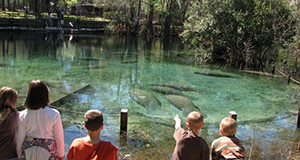Abstract
One of Florida's keystone species, manatees help to maintain healthy coastal and riverine ecosystems and are economically important for many coastal communities. Effective protection measures implemented in Florida for many years allowed state and federal regulators to reclassify manatees from Endangered to Threatened in 2017. Red tides, especially persistent blooms during winter months, can be one of the largest killers of Florida manatees, and they may become endangered again if they are subjected to increased mortality and stress. Understanding how red tides affect manatees and how can you help is critical. This 5-page fact sheet written by Brittany Hall-Scharf and Armando Ubeda and published by the UF/IFAS Florida Sea Grant College Program will explain what red tides are, how they harm manatees, and what you can do to help.
http://edis.ifas.ufl.edu/sg188
References
Brand, L. E., A. Compton. 2007. "Long-term increase in Karenia brevis abundance along the Southwest Florida Coast." Harmful Algae 6: 232-252 https://doi.org/10.1016/j.hal.2006.08.005
Capper, A., L. J. Flewelling, and K. Arthur. 2013. "Dietary Exposure to Harmful Algal Bloom (HAB) toxins in the Endangered Manatee (Trichechus manatus latirostris) and Green Sea Turtle (Chelonis mydas) in Florida, USA." Harmful Algae 28:1-9. https://doi.org/10.1016/j.hal.2013.04.009
Flewelling, L. J. 2008. Vectors of Brevetoxins to Marine Mammals. Graduate Theses and Dissertations http://scholarcommons.usf.edu/etd/243
Hoagland, P., D. M. Anderson, Y. Kaoru, and A. W. White. 2002. "The Economic Effects of Harmful Algal Blooms in the United States: Estimates, Assessment Issues, and Information Needs." Estuaries 25(4b):819-837. https://doi.org/10.1007/BF02804908
Kirkpatrick, B., L. E. Fleming, D. Squicciarini, L. C. Backer, R. Clark, W. Abraham, J. Benson, Y. S. Cheng, D. Johnson, R. Pierce, J. Zaias, G. D. Bossart, and D. G. Baden. 2004. "Literature Review of Florida Red Tide: Implications for Human Heath Effects." Harmful Algae 3(2): 99-115. https://doi.org/10.1016/j.hal.2003.08.005
Landsberg, J. H., L. J. Flewelling, and J. Naar. 2009. "Karenia brevis Red Tides, Brevetoxins in the Food Web, and Impacts on Natural Resources: Decadal Advancements." Harmful Algae 8:598-607. https://doi.org/10.1016/j.hal.2008.11.010
Morgan, K. L., S. L. Larkin, and C. M. Adams. 2007. Public Costs of Florida Red Tides, 2007. Gainesville: University of Florida Institute of Food and Agricultural Sciences. http://edis.ifas.ufl.edu/fe711
Solomon, B. D., C. M. Corey-Luse, and K. E. Halvorsen. 2004. "The Florida Manatee and Eco-Tourism: Toward a Safe Minimum Standard." Ecological Economics 50:101-115. https://doi.org/10.1016/j.ecolecon.2004.03.025
National Oceanic and Atmospheric Administration. 2011. "Endangered Ocean: Manatees." Retrieved October 23, 2018, from https://oceantoday.noaa.gov/endoceanmanatees/
VISIT FLORIDA. 2017. 2016-2017 Year in Review. VISIT FLORIDA, Tallahassee, Fl. https://www.visitflorida.org/media/39028/yearinreview2017.pdf
Unless otherwise specified, articles published in the EDIS journal after January 1, 2024 are licensed under a Creative Commons Attribution-NonCommercial-NoDerivs 4.0 International (CC BY-NC-ND 4.0) license.

